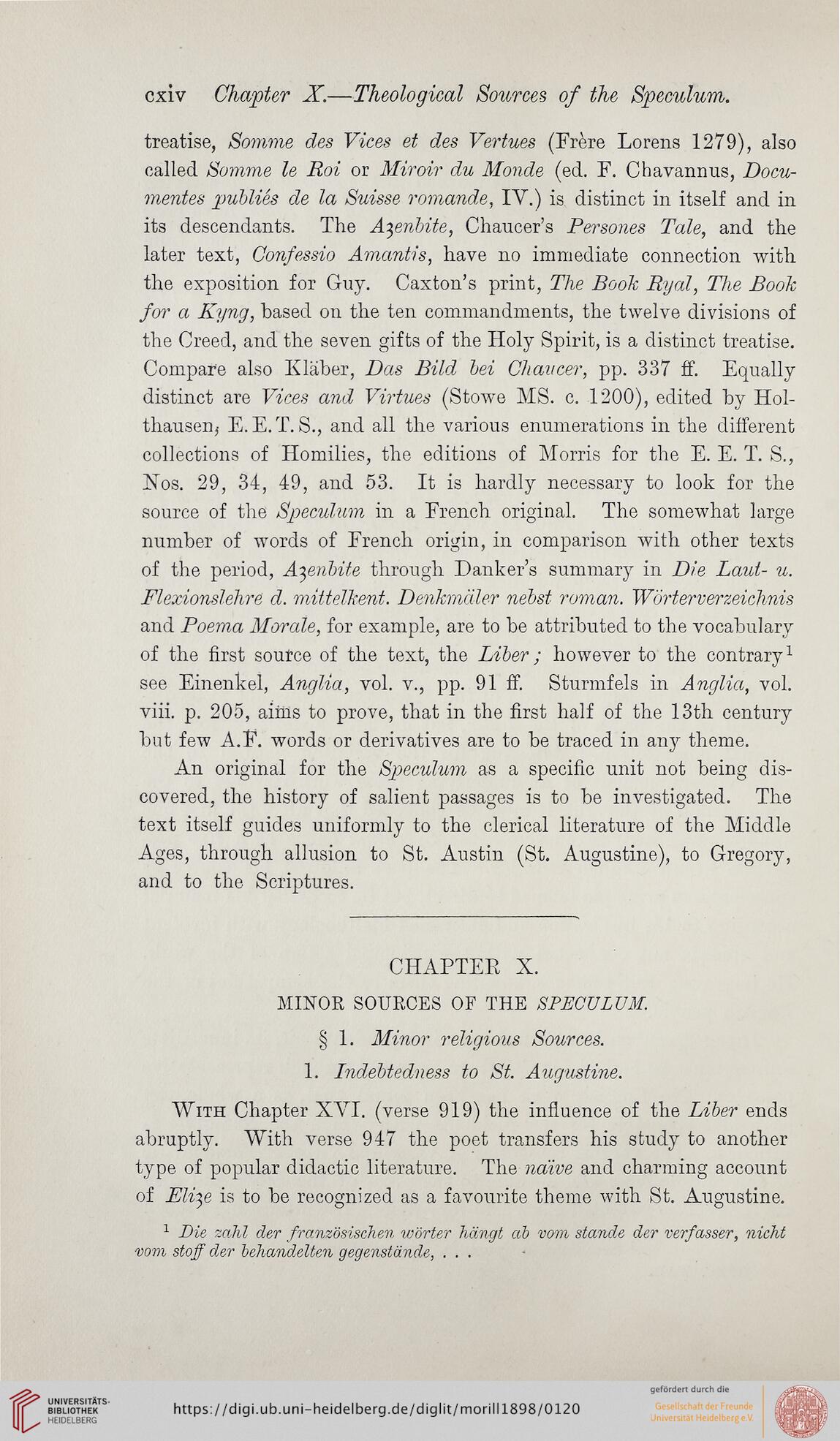cxiv Chapter X.—Theological Sources of the Speculum.
treatise, Somme des Vices et des Vertues (Frere Lorens 1279), also
called Somme le Roi or Miroir du Monde (ed. F. Chavannus, Docu-
mentes publies de la Suisse romande, IV.) is distinct in itself and in
its descendants. The A^enbite, Chaucer’s Persones Tale, and the
later text, Confessio Amantis, have no immediate connection with
the exposition for Guy. Caxton’s print, The Book Ryal, The Book
for a Kyng, based on the ten commandments, the twelve divisions of
the Creed, and the seven gifts of the Holy Spirit, is a distinct treatise.
Compare also Klaber, Das Bild bei Chaucer, pp. 337 ff. Equally
distinct are Vices and Virtues (Stowe MS. c. 1200), edited by Hol-
thausen5 E. E. T. S., and all the various enumerations in the different
collections of Homilies, the editions of Morris for the E. E. T. S.,
Nos. 29, 34, 49, and 53. It is hardly necessary to look for the
source of the Speculum in a French original. The somewhat large
number of words of French origin, in comparison with other texts
of the period, A^enbite through Banker’s summary in Die Laut- u.
Flexionslehre d. mittelkent. Denkmiiler nebst roman. Wbrterverzeichnis
and Poema Morale, for example, are to be attributed to the vocabulary
of the first source of the text, the Liber ; however to the contrary1
see Einenkel, Anglia, vol. v., pp. 91 ff. Sturmfels in Anglia, vol.
viii. p. 205, aiins to prove, that in the first half of the 13th century
but few A.F. words or derivatives are to be traced in any theme.
An original for the Speculum as a specific unit not being dis-
covered, the history of salient passages is to be investigated. The
text itself guides uniformly to the clerical literature of the Middle
Ages, through allusion to St. Austin (St. Augustine), to Gregory,
and to the Scriptures.
CHAPTER X.
MINOR SOURCES OF THE SPECULUM.
§ 1. Minor religious Sources.
1. Indebtedness to St. Augustine.
With Chapter XVI. (verse 919) the influence of the Liber ends
abruptly. With verse 947 the poet transfers his study to another
type of popular didactic literature. The naive and charming account
of Eli^e is to be recognized as a favourite theme with St. Augustine.
1 Die. zahl der franzbsischen wbrter hangt ab vom stande der verfasser, nicht
wm staff der behandelten gegenstdnde, . . .
treatise, Somme des Vices et des Vertues (Frere Lorens 1279), also
called Somme le Roi or Miroir du Monde (ed. F. Chavannus, Docu-
mentes publies de la Suisse romande, IV.) is distinct in itself and in
its descendants. The A^enbite, Chaucer’s Persones Tale, and the
later text, Confessio Amantis, have no immediate connection with
the exposition for Guy. Caxton’s print, The Book Ryal, The Book
for a Kyng, based on the ten commandments, the twelve divisions of
the Creed, and the seven gifts of the Holy Spirit, is a distinct treatise.
Compare also Klaber, Das Bild bei Chaucer, pp. 337 ff. Equally
distinct are Vices and Virtues (Stowe MS. c. 1200), edited by Hol-
thausen5 E. E. T. S., and all the various enumerations in the different
collections of Homilies, the editions of Morris for the E. E. T. S.,
Nos. 29, 34, 49, and 53. It is hardly necessary to look for the
source of the Speculum in a French original. The somewhat large
number of words of French origin, in comparison with other texts
of the period, A^enbite through Banker’s summary in Die Laut- u.
Flexionslehre d. mittelkent. Denkmiiler nebst roman. Wbrterverzeichnis
and Poema Morale, for example, are to be attributed to the vocabulary
of the first source of the text, the Liber ; however to the contrary1
see Einenkel, Anglia, vol. v., pp. 91 ff. Sturmfels in Anglia, vol.
viii. p. 205, aiins to prove, that in the first half of the 13th century
but few A.F. words or derivatives are to be traced in any theme.
An original for the Speculum as a specific unit not being dis-
covered, the history of salient passages is to be investigated. The
text itself guides uniformly to the clerical literature of the Middle
Ages, through allusion to St. Austin (St. Augustine), to Gregory,
and to the Scriptures.
CHAPTER X.
MINOR SOURCES OF THE SPECULUM.
§ 1. Minor religious Sources.
1. Indebtedness to St. Augustine.
With Chapter XVI. (verse 919) the influence of the Liber ends
abruptly. With verse 947 the poet transfers his study to another
type of popular didactic literature. The naive and charming account
of Eli^e is to be recognized as a favourite theme with St. Augustine.
1 Die. zahl der franzbsischen wbrter hangt ab vom stande der verfasser, nicht
wm staff der behandelten gegenstdnde, . . .




